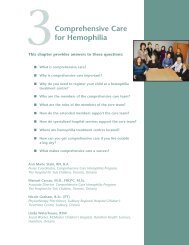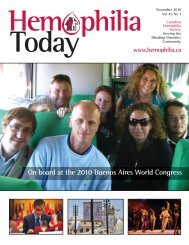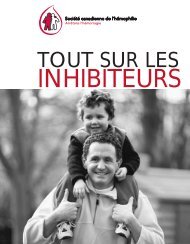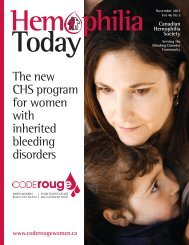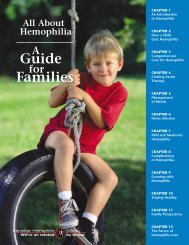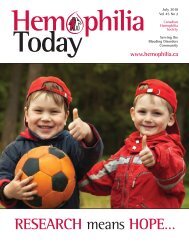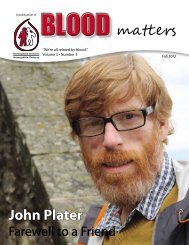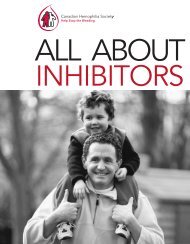Complications of Hemophilia
Complications of Hemophilia
Complications of Hemophilia
Create successful ePaper yourself
Turn your PDF publications into a flip-book with our unique Google optimized e-Paper software.
8<strong>Complications</strong><br />
<strong>of</strong> <strong>Hemophilia</strong><br />
PART 2 - Joint and Muscle Damage<br />
■<br />
Can synovitis and arthritis be prevented<br />
Yes. It is much easier to prevent joint damage than it is to treat it<br />
after it starts to develop. The best way to prevent joint damage is<br />
to prevent bleeds into the joints. This is done with prophylactic<br />
clotting factor therapy. Clotting factor can be given before<br />
bleeding actually occurs. Many children with severe hemophilia<br />
receive factor infusions on a regular basis. People with moderate<br />
hemophilia sometimes infuse factor concentrate before they<br />
participate in sports or other activities that can place stress on<br />
joints and cause bleeds. See Chapter 4, Management <strong>of</strong><br />
Bleeds; Chapter 5, Clotting Factor Therapy; and Chapter 6,<br />
The Role <strong>of</strong> Prophylaxis.<br />
Even with prophylaxis, there is no way to prevent all bleeds,<br />
especially in active toddlers. Padding the furniture, using<br />
carpeting on floors, and protective gear such as a helmet and<br />
kneepads may help to prevent and reduce bruises. However, joint<br />
bleeds are almost always caused by stress — a twist or a sprain —<br />
on the joint.<br />
“Our child was<br />
only seven when his<br />
x-ray showed serious<br />
joint damage in his<br />
target joint. He was<br />
on prophylaxis, yet<br />
it still developed.”<br />
The second best way to prevent joint damage is to recognize and<br />
treat each new joint bleed immediately. In very young children, it is<br />
<strong>of</strong>ten difficult to tell if there is swelling in a joint. However, in the<br />
early stages <strong>of</strong> a bleed you may notice that your child refuses to<br />
use an arm or a leg, or cries if that limb is moved. If clotting factor<br />
is given at this point, there will be only a small amount <strong>of</strong><br />
bleeding that needs to heal. It is also important to rest the joint —<br />
this means no walking after a knee or ankle bleed, no crawling<br />
after an elbow bleed, and no sports until the joint has fully<br />
recovered.<br />
8-14<br />
All About<br />
<strong>Hemophilia</strong><br />
A<br />
Guide<br />
for<br />
Families



